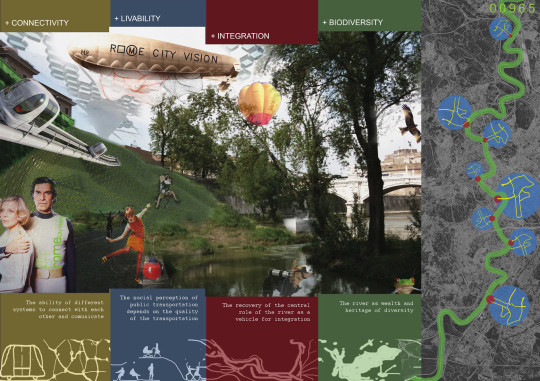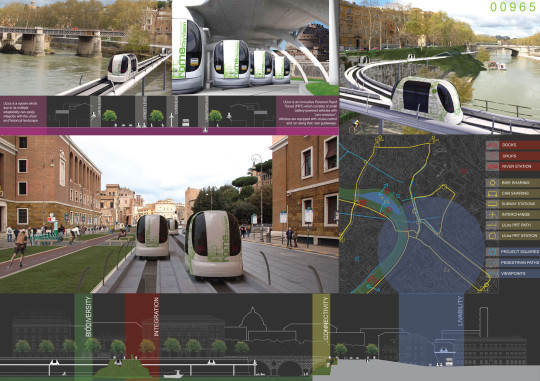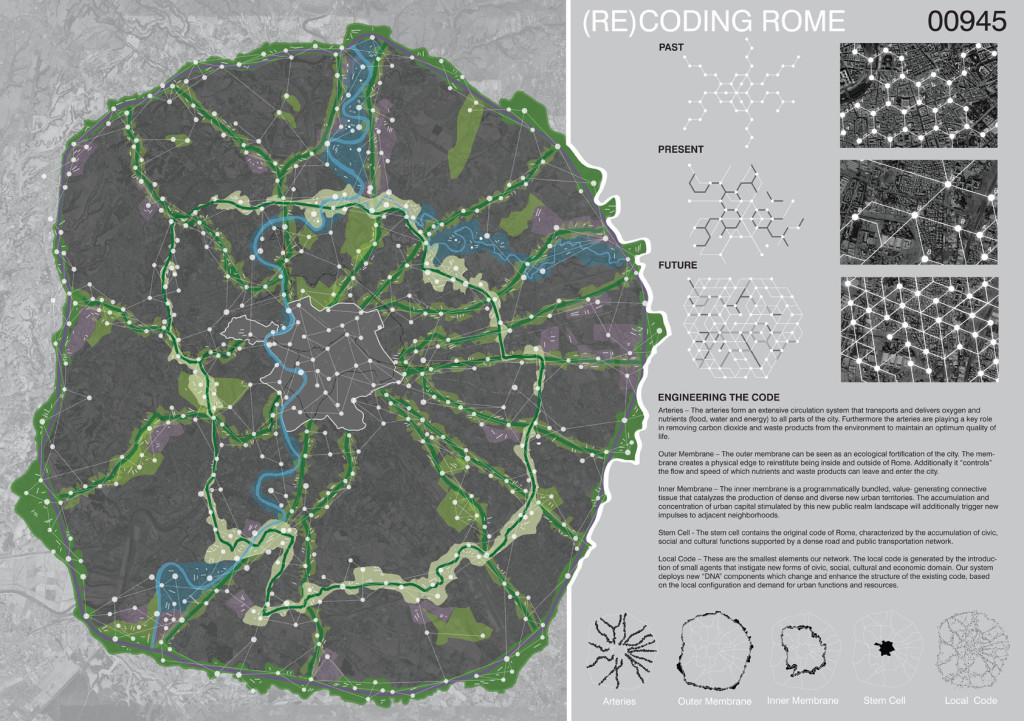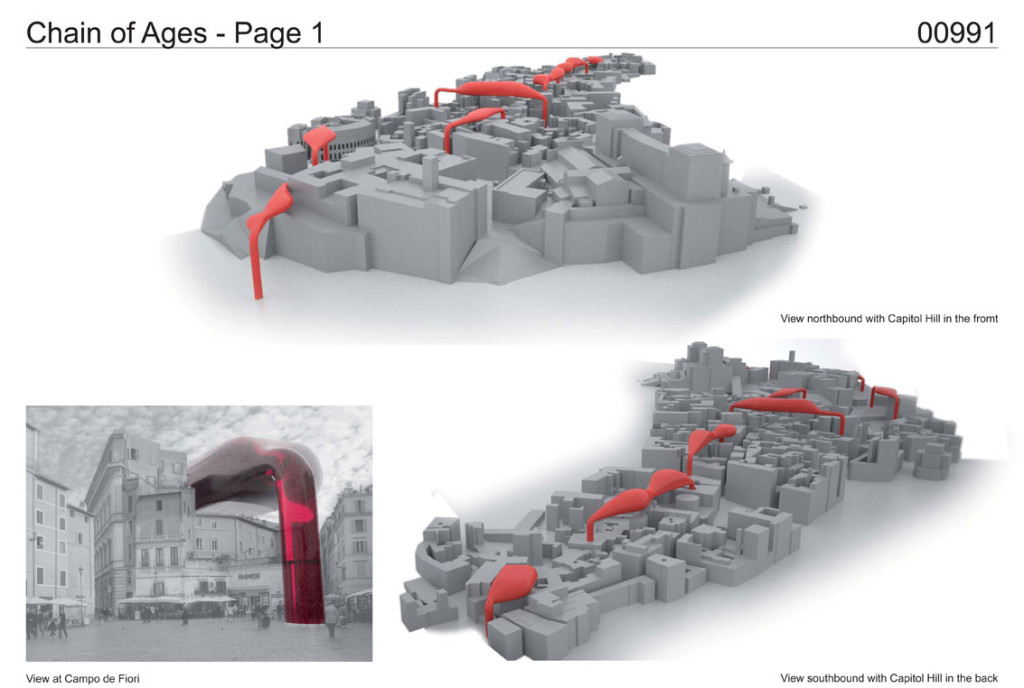Info:
Title: + Livability - Code: 00965Contest: Rome / 2010
By: M. Biagiotti / V. Botti / R. Ferabecoli / E. Moneta / G. Stefanini
Views: 2930 Likes: 0
Votes:
JUERGEN MAYER H. 0 FRANCESCO LIPARI0 FELIPE ESCUDERO4 FRANCESCO GATTI 8 MICHAEL CATON 33.0
+ Livability


+ Livability
“The social perception of public transportation depends on the quality of the transportation”
Today living in a large city like Rome means being dependent on the road network where car circulation caters for most transfers involving day-to-day business.
This leads to vehicular traffic congestion and a high level of atmospheric and noise pollution. The streets and squares of vast areas of the historic centre are transformed into car-parks for private cars and the logic of “economic growth” takes precedence over the protection of the health of the public and the historic and artistic heritage of the city.
The solution of the problem of collective transport is the first step towards the recovery and requalification of Rome. It is only be by concentrating on structural projects involving mobility that we can hope to find the livability of our city again.
+ Biodiversity
“The river as wealth and heritage of diversity”
The separation of the city from its river which has occurred over the last century was decided both by the construction along the banks of the Tiber and by changing lifestyles. This led to the progressive isolation of the river as a transport link and as one of the dynamic elements of attraction in the city.
Despite the fact that many of us today believe that the river Tiber in Rome has been reduced to the status of open-air sewer, in actual fact, even in the urban stretch its condition is still not completely compromised and is certainly better than that of many other European rivers.
The river is still home to carp, roach, eels and even marine species such as grey mullet which come upriver to feed. River channels are natural corridors which facilitate orientation and are a reference point to be followed by animals during their migration from inland to the coast of our country. During the winter months the Tiber is home to migratory birds like cormorants, egrets and herons.
+ Connectivity
“The ability of different systems to connect with each other and communicate”
The creation of a network intermodal transport seamless transfer from one mode to another, would move faster and less invasive of the other requirements of city life.
The central idea of our planning vision is that through the creation of a public transport network which uses systems such as ULTra www.ultraprt.com a valid alternative use of the road network by private vehicles can be proposed in vast areas of the city.
ULTra is a Personal Rapid Transit (PRT) system. It is an innovative system which consists of small battery-powered vehicles with “zero emissions”, equipped with a cruise control system and which travel along their own guideways similar to roads.
The part of N.P.R.G. of Rome on “context of strategic planning of the Tiber” focuses on the changing concept of what is now a distance, in a resource for the city, involving again the river to enhance and transform it into a strategic axis.
The river Tiber channel along its city stretch is seen as a primary link, which by means of precise and carefully considered entry-points could connect vast areas of the city.
Can be thought of a series of stops in nodal points, where connect with existing transport system: the underground and tram stops, the bike and car sharing stations, etc..
It could be possible to connect our archeological heritage ( Foro Boario, Circo Massimo, Palatine and Fori Imperiali ), the areas of “industrial archeology” ( Ostiense, ex Abattoir ), the areas dedicated to sport ( Foro Italico, Olympic Stadium and Olympic Village and beyond to Acqua Acetosa ), characteristic neighborhoods ( from Trastevere and Testaccio to S. Paolo, Garbatella and as far as Eur ). Various cultural centres could be connected ( from Renzo Piano’s Auditorium to the new MAXXI, Piazza del Popolo with Pincio, Ara Pacis and continuing on to Castel S. Angelo and the Vatican, Isola Tiberina, Velabro, San Michele etc. ).
+ Integration
“The recovery of the central role of the river as a vehicle for integration”
ULTra system, for its multiple adaptability, can easily integrate with the urban and historical situation of Rome.
It can run along the Tiber with its suspended cantilever rail, can follow the embankments, cross the river as a bridge, enter the urban fabric either below ground level or elevated.
The stations on the Tiber are thought of as elements of primary integration between the river and its city, as elements of connection between the various transport systems which function in its vicinity, as an ideal union between the waterway and the urban fabric which by means of a green link calls the citizens to get to know their river Tiber.
The actual vehicle (PRT) station can be built with reinforced concrete below the Lungotevere road and with large free openings overlooking the Tiber. The green part, which is more evident and communicative from the symbolic point of view is thought of as a modular cage structure in painted steel which would have an internal substratum suitable for growing a wall of vegetation.
This horticultural architecture has its roots in water, thereby creating the natural conditions for the safeguarding of the river’s vitality. It will become the place where silt transported by the river is deposited, where the micro-organisms which help the plants to grow will live, where the animals and people who live in our city can find shelter.






